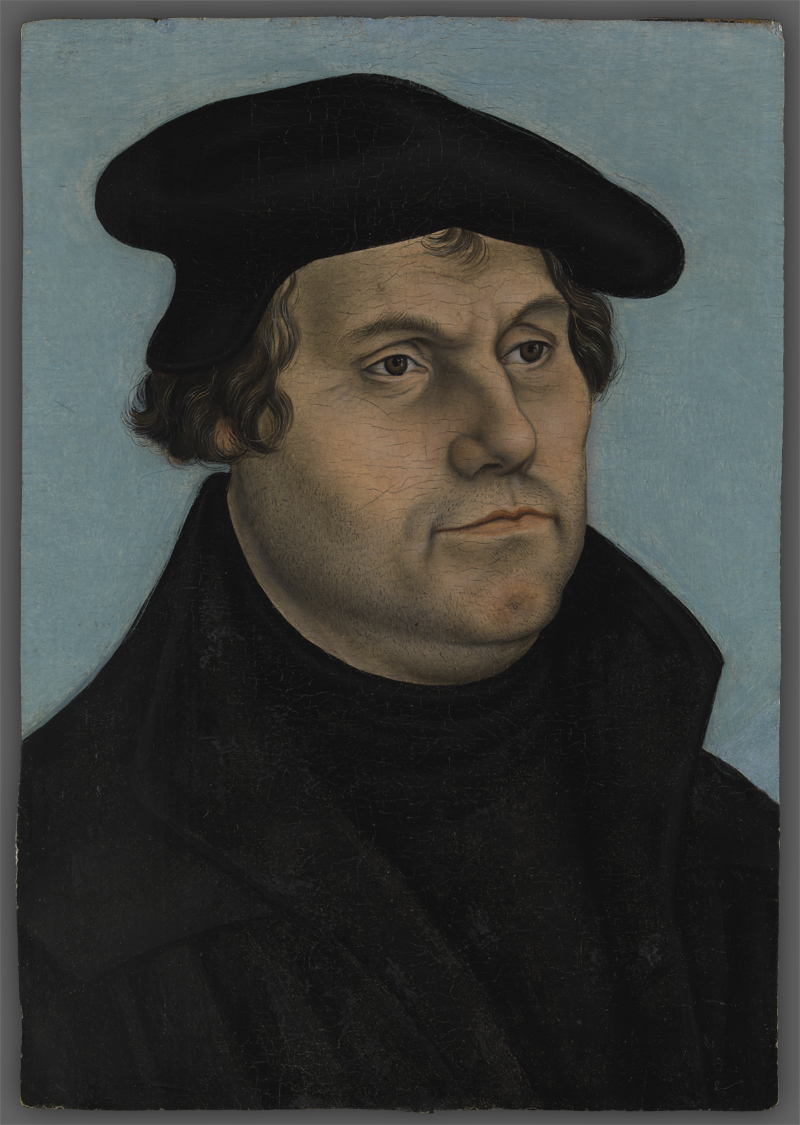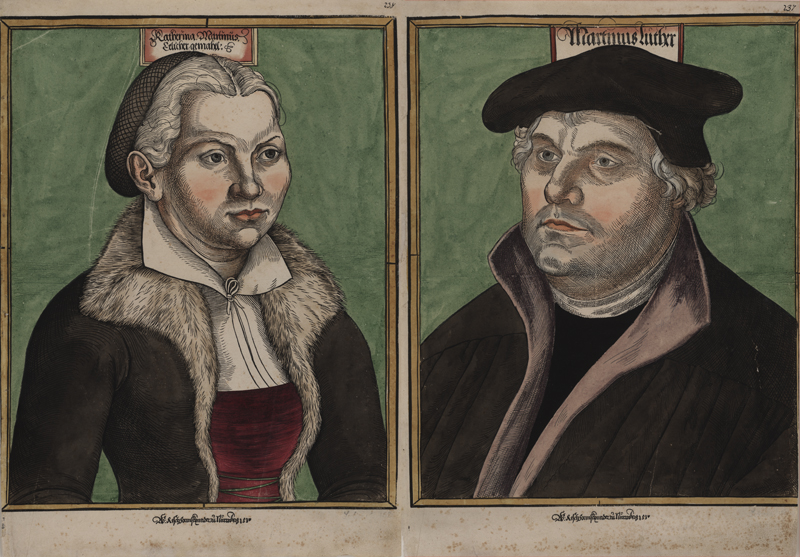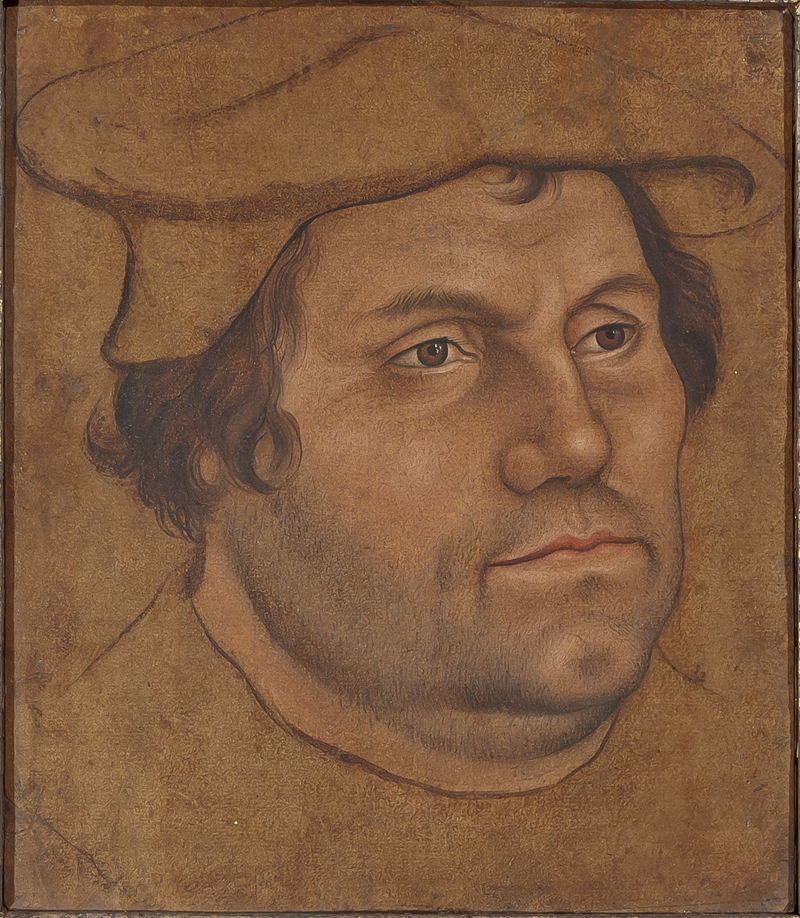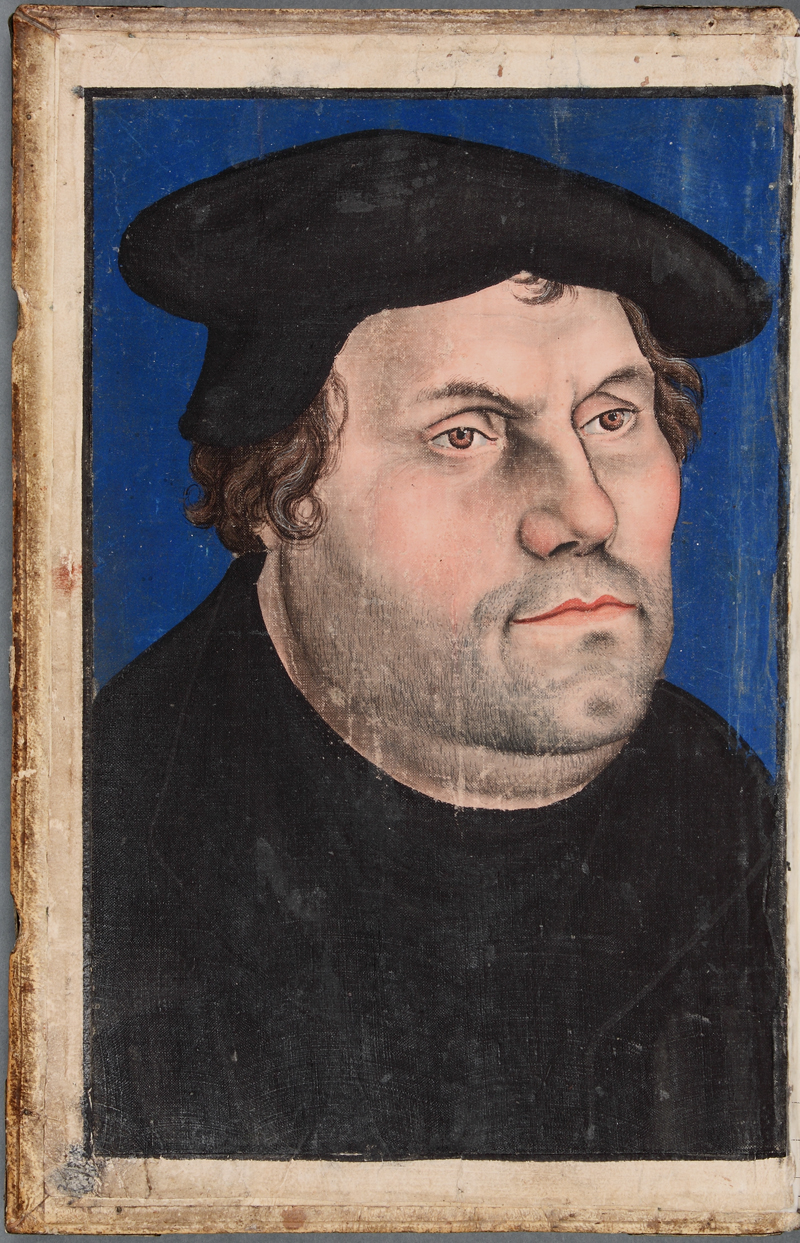
Bust length Portrait of Martin Luther wearing a Cap (from 1530)

Abb. 1: Werkstatt Lucas Cranach der Ältere, Martin Luther im Brustbild mit Barett, zur Seite blickend, ab 1530, Malerei auf Buchenholz, The Metropolitan Museum of Art, New York, KKL-Nr. V.M2

Abb. 2: Hans Brosamer (?), Doppelbildnis Martin Luthers und Katharina von Boras, 1530, Holzschnitt mit Typendruck, Stiftung Schloss Friedenstein Gotha, KKL-Nrn. V.D1a und V.D1b
Portrait Group V consists of the earliest examples from a portrait type that was produced in large numbers from about 1530 to the 1540s and is represented by two different portrait lengths (fig. 1). Since the period under study ends in 1530 the KKL has only registered the first and formative examples from this Portrait Group, which is crucial for the further reception of Luther. These include a panel painting (V.M1), a ‘Tüchlein’ (V.M2), a portrait study on paper (V.Z1) and two printed sheets (V.D1a-b).
The depiction of Luther with cap and gown differs only in some minor details from the earlier portrait type, Group IV. Luther appears somewhat more fleshy, the growth of stubble on his chin is emphasized and he looks to the side as he does in the earlier marriage portraits. Whereas V.Z1, V.M1 and V.M2 survive without their companion pieces, in the prints Luther is paired with the well-known portrait of Katharina of Bora and later with Philipp Melanchthon (V.D-Sup01).
Two panel paintings bearing inscriptions from the year 1532, one in Copenhagen and the other in a private collection, provide a point of reference for the earliest occurrence of this portrait type. However, the earliest examples of this series may have already been produced by 1530 as will be explained below.
Since 1930 the printed portraits (V.D1a-b), printed by the Nuremberg blockcutter Wolfgang Resch, have been attributed to Hans Brosamer (fig. 2).[1] A third woodcut, a portrait of Melanchthon (V.D-Sup01), represents a later addition that allowed the Luther portrait to be paired with Melanchthon as an alternative.[2] The portraits of Luther and Bora are both dated 1530 in the printer’s address placed beneath their images, confirming that this portrait type must have already existed in that year.[3] It can be assumed that Cranach – as with the evolution of the previous portrait types – rather than Brosamer invented this portrait type. This is clearly illustrated by Brosamer’s use of a portrait type for Katharina of Bora that had been developed in the Cranach workshop a few years earlier.[4]
[1] This was recently questioned. See New Hollstein German Hans and Martin Brosamer Part III, 175.1312.
[2] From 1532, the year in which the Cranach workshop began to put the portrait of Melanchthon at Luther’s side, this innovation is also reflected in the prints supplied by Brosamer. See the catalogue entry for V.D-Sup01.
[3] See the catalogue entry for V.D1a and V.D1b.
[4] Moreover, the facial contours of the Luther portrait correspond in form and actual size with the three painted versions from the Cranach workshop (V. Z1, V.M1, V.M2).

Abb. 3: Lucas Cranach d. Ä., Martin Luther im Brustbild mit Barett, zur Seite blickend, um 1530, Pinsel in Braun und Schwarz sowie Deckfarben auf Vergépapier, The Duke of Buccleuch, Drumlandig Castle, Thornhill, KKL-Nr. V.Z1

Abb. 4: Lucas Cranach d. Ä. und Werkstatt, Martin Luther im Brustbild mit Barett, zur Seite blickend, um 1530-1532, Malerei auf Leinwand/Tüchlein, The Duke of Buccleuch, Drumlandig Castle, Thornhill, KKL-Nr. V.M1
A portrait study by Cranach that exists as a brush drawing on paper in Thornhill (V.Z1) (fig. 3) can be placed at the beginning of this portrait series as it is presumably the preparatory sketch for this portrait type (fig. 4).[1] It concentrates solely on the face, only hinting at the head-attire and clothes. It can be dated to 1530 at the latest.[2] A portrait on finely woven canvas in Bad Windsheim (V.M2) municipal library closely follows this prototype.[3] As one of the few surviving works on canvas by Cranach the Elder and his workshop this painting has a special position among the Luther portraits. Although it was pasted onto the flyleaf of a bible published in 1535 the portrait was probably created a few years earlier.[4] The only panel painting dealt with from this group, which is now in the Metropolitan Museum New York (V.M1), is also closely related to the brush drawing in Thornhill. Unlike the aforementioned panel in Copenhagen the version in New York is not dated and could therefore have already been painted by 1530.[5]
This Portrait Type, recorded between 1530 and 1532, appears to usher in a new arrangement for the double portraits. By 1532 the position at Luther’s side occupied ‘in effigie’ by Katharina of Bora from 1525 to 1529/30 had, at least in painted versions, already been taken by Melanchthon. This series of double portraits was also produced in large quantities. Only closer analysis of the as yet barely researched conditions under which these double portraits were produced and their context of use can determine the extent to which, in this stage-management of Luther and Melanchthon as partners in the tradition of humanistic friendship paintings, processes of internal reformation consolidation (Visitation 1528, Catechism 1529 and Confession 1530) and of external reformation alliance policy (Schmalkaldic League 1531 and the Peace of Nuremberg 1532) are reflected.[6]
[1] Both the superimposed tracings, showing the main details and inner contours on the painting from the Metropolitan Museum New York (V.M1) and the Tüchlein from Bad Windsheim (V.M2) correspond. A projection onto the version in Copenhagen [DK_SMK_KMSsp720](https://lucascranach.org/DK_SMK_KMSsp720), dated 1532, also revealed largely matching facial contours. However, it is apparent that the mouth is slightly broader in the portrait study and that the iris in the right eye is positioned further out. On the other hand the eyes and the mouths in all the paintings correspond. It can be assumed that the paintings were prepared using a template, which had been slightly modified in comparison with the portrait study. In this context it must be pointed out that no evidence of a transfer method was found on any of the recorded and only faintly visible underdrawings in this Portrait Group. The broken lines and double contours characteristic of Portrait Group IV are not present or cannot be detected. To establish whether this is due to a change in the process and/or the paint medium used to transfer the design would require a comparative examination of portraits from this series that were painted after the prescribed investigation period.
[2] See classification text for V.Z1.
[3] See classification text for V.M2.
[4] See ibid.
[5] The panel has not yet been subjected to a dendrochronological examination has, see the report on the dendrochronological examination [US-MMANY_55-220-2] (https://lucascranach.org/US-MMANY_55-220-2).
[6] See Kaufmann 2009, pp. 606–608.